- Visibility 85 Views
- Downloads 32 Downloads
- DOI 10.18231/j.ijfmts.2020.030
-
CrossMark
- Citation
Epidemiological profile of fatal vehicular accidents in rural region of Maharashtra
- Author Details:
-
Raut S. M
-
Haridas S.V *
Introduction
A Vehicular accident can be defined as an event that occurs on a way or street open to public traffic; resulting in one or more persons being injured or killed, where at least one moving vehicle is involved. Rapid urbanization, motorization, lack of appropriate road engineering, poor awareness levels, lacking injury prevention programs, and poor enforcement of traffic laws has exacerbated the situation.[1] According to a report by World Health Organization, over 1.2 million people died from Vehicular accidents each year in the world and about 50 million were injured. It was predicated that the injuries related to Vehicular accidents will rise to become the fifth leading cause of death by 2030.[2] Injuries caused due to vehicular accidents is the leading cause of death among people aged between 5 and 29 years. 90% of the world's fatalities on the roads occur in low and middle income countries, even though these countries have approximately 60% of the world's vehicles.[3] This study is conducted in a rural region of Maharashtra where people were adapted to village roads since a long time. The road accident report of 2018 showed that West Bengal topped the list of pedestrian fatalities with 2618 deaths followed by Maharashtra 2515 deaths.[4] The problems of people living in rural region are different from urban area regarding vehicular accidents. Many studies have been conducted to study epidemiological factors, distribution and patterns of fatal vehicular accidents in metro cities and urban areas. Hence in this study, a sincere effort has been made to study epidemiology of fatal vehicular accidents in rural region and to suggest measures to be taken to decrease it.
Aims and Objectives
To study epidemiological factors such as age, sex, religion, education, occupation, diurnal and seasonal distribution, categories of victims and contributing factors related to fatal vehicular accidents.
Material and Methods
A Prospective study was carried out in the mortuary of Department of Forensic Medicine, Swami Ramanand Teerth Rural Government Medical College and Hospital, Ambajogai Dist. Beed, Maharashtra, India during the period of May 2016 to April 2020.
Inclusion criteria
All Fatal Vehicular Accidents cases brought for autopsy.
Exclusion criteria
All cases other than Fatal Vehicular Accidents.
Proforma for study was prepared and various information and findings were collected like age, sex, religion, education, occupation, diurnal and seasonal distribution, categories of victims and contributing factors related to fatal vehicular accidents. Additional information was derived from police investigation report and statements of the relatives. The information was compiled, tabulated and analyzed statistically.
Results
During the study period a total of 1934 autopsies were conducted, out of which 1385 (71.62%) were unnatural. Out of these unnatural deaths 216 (15.60%) cases were because of vehicular accidents. Predominance of males were seen in 194 cases (89.8%) with male: female ratio of 8.8:1. Age group 51-60 years was more commonly involved i.e. 44 cases (20.4%) followed by age group 21-30 years i.e. 42 cases (19.4%) ([Figure 1]). After applying statistical test, mean age was 39.9 years and mode was 40 years. Predominance of Hindus were observed in 192 cases (88.9%) ([Table 1]). 66 cases (30.6%) were illiterate followed by those completed primary and intermediate school; 58 cases (26.9%). Least cases were noted in post graduates; 14 cases (6.5%) ([Table 2]). 40 cases (18.5%) were laborer by occupation and students were also 40 (18.5%) in number, followed by farmers (16.7%) and owners of private business (16.7%) ([Table 3]). In 76 cases (35.2%) victim was Motor Cycle Rider followed by pedestrians in 66 cases (30.6%) ([Table 4]). Maximum accidents were occurred on national highways (32.4%), followed by village roads (25%), city roads (22.2%) and state highways (20.4%) (Figure No. 2). Maximum deaths i.e. 82 (38%) were noted in the evening hours (06.00 PM – 08.59 PM), followed by 40 cases (18.5%) during 09.00 PM – 11.59 PM ([Figure 3]). More deaths were seen in winter season i.e. 76 cases (35.2%) ([Figure 4]). It was evident that rash driving i.e. human error was responsible for mishaps in 98 cases (45.4%), followed by no use of safety measures in 36 cases (16.7%) ([Figure 5]).
|
S. No. |
Religion |
Total |
% |
|
1 |
Hindu |
192 |
(88.9%) |
|
2 |
Muslim |
24 |
(11.1%) |
|
3 |
Total |
216 |
(100%) |
|
S. No. |
Education Status |
Total |
% |
|
1 |
Uneducated |
66 |
(30.6%) |
|
2 |
1st Std. – 10th Std. |
58 |
(26.9%) |
|
3 |
11th Std. – 12th Std. |
34 |
(15.7%) |
|
4 |
Graduate |
44 |
(20.4%) |
|
5 |
Post Graduate |
14 |
(6.5%) |
|
6 |
Total |
216 |
(100%) |
|
S. No. |
Occupation |
Total |
% |
|
1 |
Farmer |
36 |
16.7 |
|
2 |
Worker/Laborer |
40 |
18.5 |
|
3 |
Drivers |
16 |
7.4 |
|
4 |
Students |
40 |
18.5 |
|
5 |
Government Servant |
32 |
14.8 |
|
6 |
Private Business |
36 |
16.7 |
|
7 |
Others |
16 |
7.4 |
|
8 |
Total |
216 |
100.0 |
|
S. No. |
Category of Victim |
Total |
% |
|
1 |
Pedestrian |
66 |
30.6 |
|
2 |
Pillion Rider |
24 |
11.1 |
|
3 |
Motor Cycle Rider |
76 |
35.2 |
|
4 |
3W & 4W Drivers |
10 |
4.6 |
|
5 |
Passengers |
34 |
15.7 |
|
6 |
Multi-axle Vehicle Driver |
06 |
2.8 |
|
7 |
Total |
216 |
100.0 |
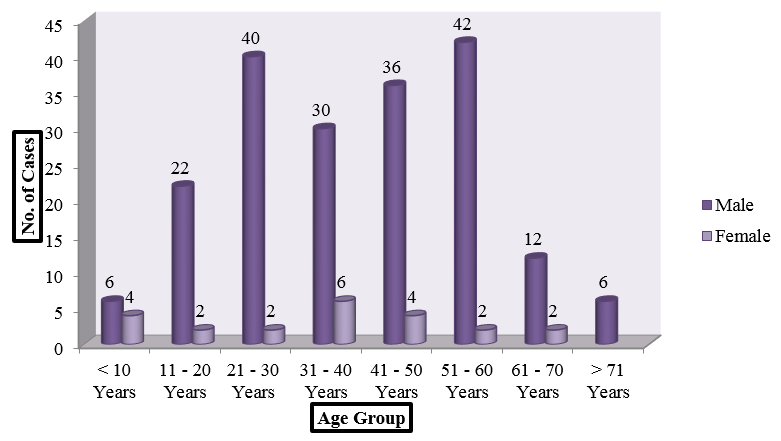
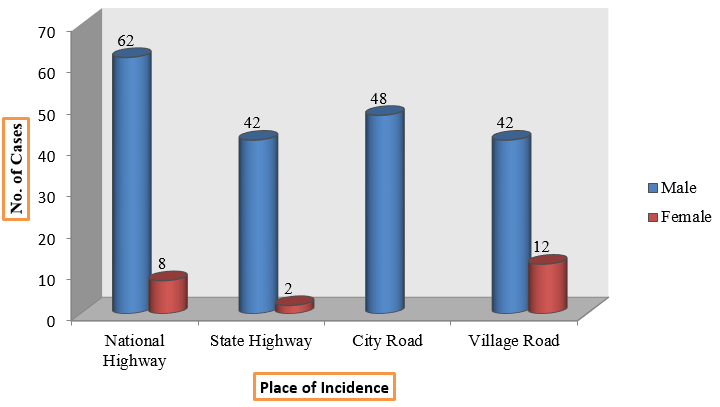
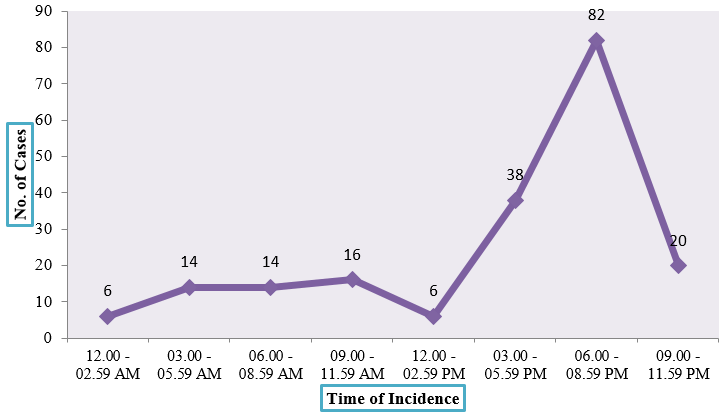
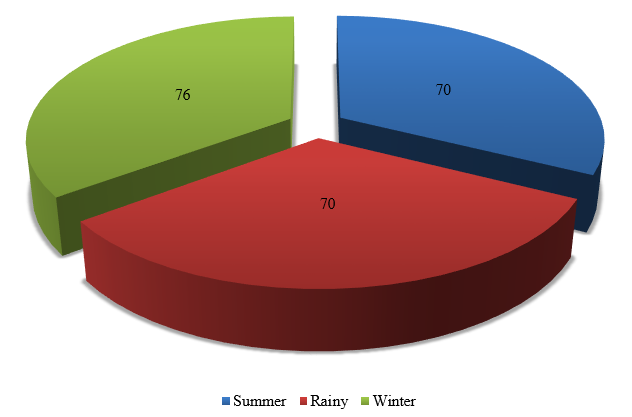
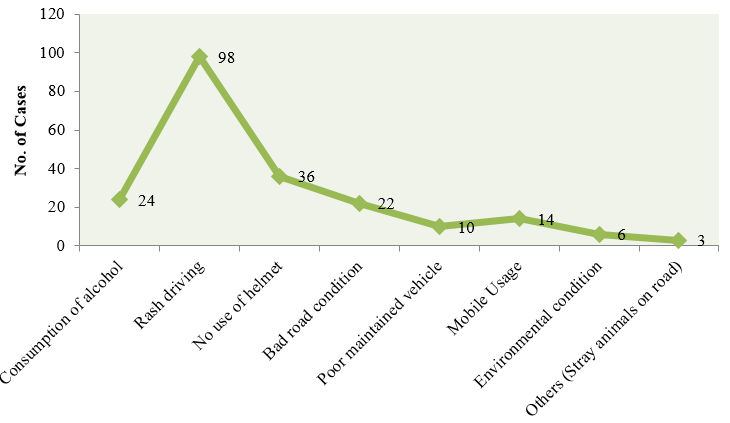
Discussion
We observed the predominance of males in 194 cases (89.8%) with male: female ratio of 8.8:1. Males being the earning member in majority of families in rural area are exposed more frequently to outdoor activities than females. Similar results were also noted by Harnam Singh,[5] Amit Patil,[6] Tanuj Kanchan[7] and Swapnil Akhade.[8]
Age group 51-60 years was more commonly involved i.e. 44 cases (20.4%) followed by age group 21-30 years i.e. 42 cases (19.4%). The reasons could be unavailability of footpaths for aged people to walk due to encroachment of shops, illegal constructions etc. Rash driving by vehicle users add burden to this problem. Other factors could be slower reflexes, weakening of eyesight and physique of people in this age group. Similar result was observed by Supriya Keisham.[9]
In this present study, we observed the predominance of Hindus in 192 cases (88.9%). It is due to more numbers of Hindus are located in and around the region where study is conducted. This study is in accordance with Rajeev Kumar Banzal,[10] Ananda Reddy[11] and Vishal Koulapur.[12]
It was observed that, 66 cases (30.6%) were illiterate followed by those completed primary and intermediate school were 58 cases (26.9%). If considered below secondary education, cases were more than half i.e. (57.5%). Low education implies no knowledge regarding traffic rules, traffic signs and boards, lack of sense of lane discipline, wrong attitude and rash behavior. These results are in accordance with Ananda reddy.[11] Amrendra kumar[13] and Aditya Baruah.[14] Least cases were noted in post graduates i.e. 14 cases (6.5%). This may be because of their higher education and morals.
Maximum victims (18.5%) were laborer by occupation and students (18.5%), followed by farmers (16.7%) and owners of private business (16.7%). Ananda Reddy[11] and Jha N[15] observed similar results.
In 76 cases (35.2%) victim was Motor Cycle Rider followed by pedestrians in 66 cases (30.6%). Number of two wheeler vehicles is more in rural region due to low economy. Motor cycles are used to carry moderate to heavy weight which disturbs the balance leading to accidents. Rash driving as discussed earlier is also important factor. Supriya Keisham,[9] Vishal Koulapur,[12] Aditya Baruah[14] and Khajuria B[16] also found similar results.
Maximum accidents were occurred on National Highways (32.4%), followed by village roads (25%), city roads (22.2%) and state highways (20.4%). National highways are being constructed in this rural region in recent times as part of National Highway Development Program. People living in this area are not yet adapted to such roads. Lack of knowledge regarding traffic rules and discipline of lanes, more fatal accidents were occurred on national highways. Village roads are old conventional roads with bad condition. Many a times they are not repaired and fatalities happened at these roads especially of farmers and pedestrians. Incidence of vehicular accidents on national highways was observed as 56.6%, 55.6% and 83.05% by Honnungar,[17] Bharath Kumar Guntheti[18] and Archana Kaul[19] respectively. This finding is not in accordance with our study as their studies were conducted in metro cities where number of national highways are more.
During this study we note that 82 cases (38%) were occurred in the evening hours (06.00 PM – 08.59 PM), followed by 40 cases (18.5%) during 09.00 PM – 11.59 PM. Evening hours is the time of congestion over roads, coupled with the fact that as everybody is in hurry to return back to home from their jobs during evenings and lighting conditions are poor on most of the roads, particularly on the outskirts of city as well as surrounding sub urban and rural areas. Similar results were observed by Aditya Baruah,[14] Anuj Gupta,[20] Suresh Katageri[21] and Akhilesh Pathak.[22]
In this study more deaths occurred in winter (35.2%), followed by summer and rainy season (32.4%) each. There is no significant difference in season wise distribution of cases in this study. Harnam Singh[23] and Kh. Pradipkumar Singh[24] noted similar results.
It was evident that rash driving i.e. human error was responsible for mishaps in 98 cases (45.4%), followed by no use of safety measures in 36 cases (16.7%), consumption of alcohol in 24 cases (11.1%). Over speeding and rash driving combined with alcohol intoxication is more dangerous leading to increased mortality. None of the motor cycle rider brought for autopsy wore helmet. Ananda Reddy [11] found rash driving in 15% cases. Bharath Kumar Guntheti [18] found human error i.e. rash driving as the commonest contributing factor. James JVP Kalougivaki [25] observed human behavioral error in (93.1%) cases.
Conclusion
The incidence of fatal vehicular accident is 15.60%.
Fatal vehicular accident has male predominance with more victims from age group 51-60 years followed by 21-30 years.
Maximum deaths were found in illiterate. They were laborers and students.
Maximum mishaps occurred on national highways and occurred in evening hours.
Most common category of victim was Motor Cycle Rider, followed by pedestrians.
We recommend the following suggestions based on our observations.
Suggestions
We can do a lot to reduce vehicular accidents as they are preventable. Multi factorial approach is needed to prevent vehicular accidents and to minimize their consequences. Some simple suggestions are as follows.
Safety education must begin from school level. Drivers need to be trained in an authorized center dealing with proper maintenance of vehicles, safety measures such as wearing seatbelts and use of other car safety measures such as head restraints and use of first aid.
Strict enforcement of law is a need of hour.
Unauthorized and illegal encroachments on the roads should be dealt with strict measures.
Sign boards, lane markings, and road signals must be properly maintained.
Without knowing a cause, you cannot find a cure. So, accurate collection of evidences from the site and its analysis is required.
There is no complete cure that will prevent all vehicular accidents. An organized team work by people in many disciplines such as engineers, medical practitioners, psychologists and law enforcing agencies is required for effective prevention of road accidents and to minimize their consequences.
Conflict of Interest
None.
Source of Funding
None.
References
- . Road Traffic Accidents | National Health Portal of India. 2020. [Google Scholar]
- . WHO | Global status report on road safety. 2018. [Google Scholar]
- . Road traffic injuries. . [Google Scholar]
- . 62 pedestrians die daily in India. Times of India. 2020. [Google Scholar]
- H Singh, S K Dhattarwal. Pattern and distribution of injuries in fatal road traffic accidents in rohtak (haryana). J Indian Acad Forensic Med 2004. [Google Scholar]
- A Patil, W Vaz. Pattern of Fatal Blunt Head Injury : A Two Year Retrospective / Prospective Medico Legal Autopsy Study. J Indian Acad Forensic Med 2010. [Google Scholar]
- T Kanchan, V Kulkarni, S M Bakkannavar, N Kumar, B Unnikrishnan. Analysis of fatal road traffic accidents in a coastal township of South India. J Forensic Leg Med 2012. [Google Scholar] [Crossref]
- S P Akhade, K R Rohi, M B Parchake, R V Kachare, S Kadam, C R Dode. Socio-demographic Profile of Head Injury Victims of Fatal Vehicular Accidents in Semi urban Region of Maharashtra. J Indian Acad Forensic Med 2015. [Google Scholar] [Crossref]
- S Keisham, SB Singh, R Kamei, P Memchoubi. A Study of Fatal Internal Injuries without Significant External Injuries in Road Traffic Accidents in Imphal from 2009–2014. J Indian Acad Forensic Med 2015. [Google Scholar] [Crossref]
- RK Banzal, A Jaiin, J Yadav, B.P. Dubey. Pattern and Distribution of Head Injuries in Fatal Road Traffic Accidents in Bhopal Region of Central India. J Indian Acad Forensic Med 2015. [Google Scholar] [Crossref]
- A Reddy, R Balaraman. Epidemiological Study of Two Wheeler Accident Victims In Rural South India. J Indian Acad Forensic Med 2016. [Google Scholar] [Crossref]
- V Koulapur, AB Mugadlimath, K Ali, K A Junaidi. Epidemiological Profile of Road Traffic Fatalities: A Retrospective Study of Autopsied Cases at Belagavi, Karnataka. J Indian Acad Forensic Med 2018. [Google Scholar] [Crossref]
- A Kumar, P K Tiwari, S K Rai, S K Pandey. Epidemiological study of blunt abdominal trauma in road traffic accident in Varanasi region. Pharma Innov J 2018. [Google Scholar]
- AM Baruah, R Chaliha. A Study of Incidence of Alcohol Use In Fatal Road Traffic Accidents. J Indian Acad Forensic Med 2015. [Google Scholar] [Crossref]
- N Jha, D Srinivasa, G Roy, S Jagdish. Epidemiological study of road traffic accident cases: A study from South India. Indian J Community Med 2004. [Google Scholar]
- B Khajuria, R Sharma, A Verma. A Profile of the Autopsies of Road Traffic Accident Victims in Jammu. J Clin Diagnostic Res 2008. [Google Scholar]
- R S Honnungar, S C Aramani, V K Ag, A K Ts, P S Jirli. An Epidemiological Survey of Fatal Road Traffic Accidents and their Relationship with Head Injuries. J Indian Acad Forensic Med 2011. [Google Scholar]
- B K Guntheti, UP Singh. Pattern of Injuries due to Fatal Road Traffic Accidents in and around Khammam. J Indian Acad Forensic Med 2017. [Google Scholar] [Crossref]
- A Kaul, U S Sinha, A K Kapoor, Y K Pathak, S Sharma, A Singh. An epidemiological study of fatal road traffic accidents in allahabad region. IIJFMT 2005. [Google Scholar]
- A Gupta, A Kumar, P Gupta, A Verma, R Kumar. A study of pattern of fatal head injuries sustained during road traffic accidents in Western Uttar Pradesh. J Indian Acad Forensic Med 2018. [Google Scholar] [Crossref]
- S Katageri, R B Sharma, HC Govindaraju, A K Singh. Pattern of Injuries in Road Traffic Accidents at Chitradurga Karnataka: An Autopsy Based Study. J Indian Acad Forensic Med 2015. [Google Scholar] [Crossref]
- A Pathak, N L Desania, R Verma. Profile of Road Traffic Accidents & Head Injury in Jaipur (Rajasthan). J Indian Acad Forensic Med 2008. [Google Scholar]
- H Singh, A D Aggarwal. Fatal Road Traffic Accidents among Young Children. J Indian Acad Forensic Med 2010. [Google Scholar]
- K P Singh, D Slong, T M Devi. Pattern of Road Traffic Accidents in Imphal. J Indian Acad Forensic Med 2012. [Google Scholar]
- J Kalougivaki, R Goundar. Retrospective Autopsy Based Study of Fatal Road Traffic Accidents in Fiji. J Forensic Res 2014. [Google Scholar] [Crossref]
How to Cite This Article
Vancouver
M RS, S.V H. Epidemiological profile of fatal vehicular accidents in rural region of Maharashtra [Internet]. IP Int J Forensic Med Toxicol Sci. 2025 [cited 2025 Sep 07];5(4):130-134. Available from: https://doi.org/10.18231/j.ijfmts.2020.030
APA
M, R. S., S.V, H. (2025). Epidemiological profile of fatal vehicular accidents in rural region of Maharashtra. IP Int J Forensic Med Toxicol Sci, 5(4), 130-134. https://doi.org/10.18231/j.ijfmts.2020.030
MLA
M, Raut S., S.V, Haridas. "Epidemiological profile of fatal vehicular accidents in rural region of Maharashtra." IP Int J Forensic Med Toxicol Sci, vol. 5, no. 4, 2025, pp. 130-134. https://doi.org/10.18231/j.ijfmts.2020.030
Chicago
M, R. S., S.V, H.. "Epidemiological profile of fatal vehicular accidents in rural region of Maharashtra." IP Int J Forensic Med Toxicol Sci 5, no. 4 (2025): 130-134. https://doi.org/10.18231/j.ijfmts.2020.030
